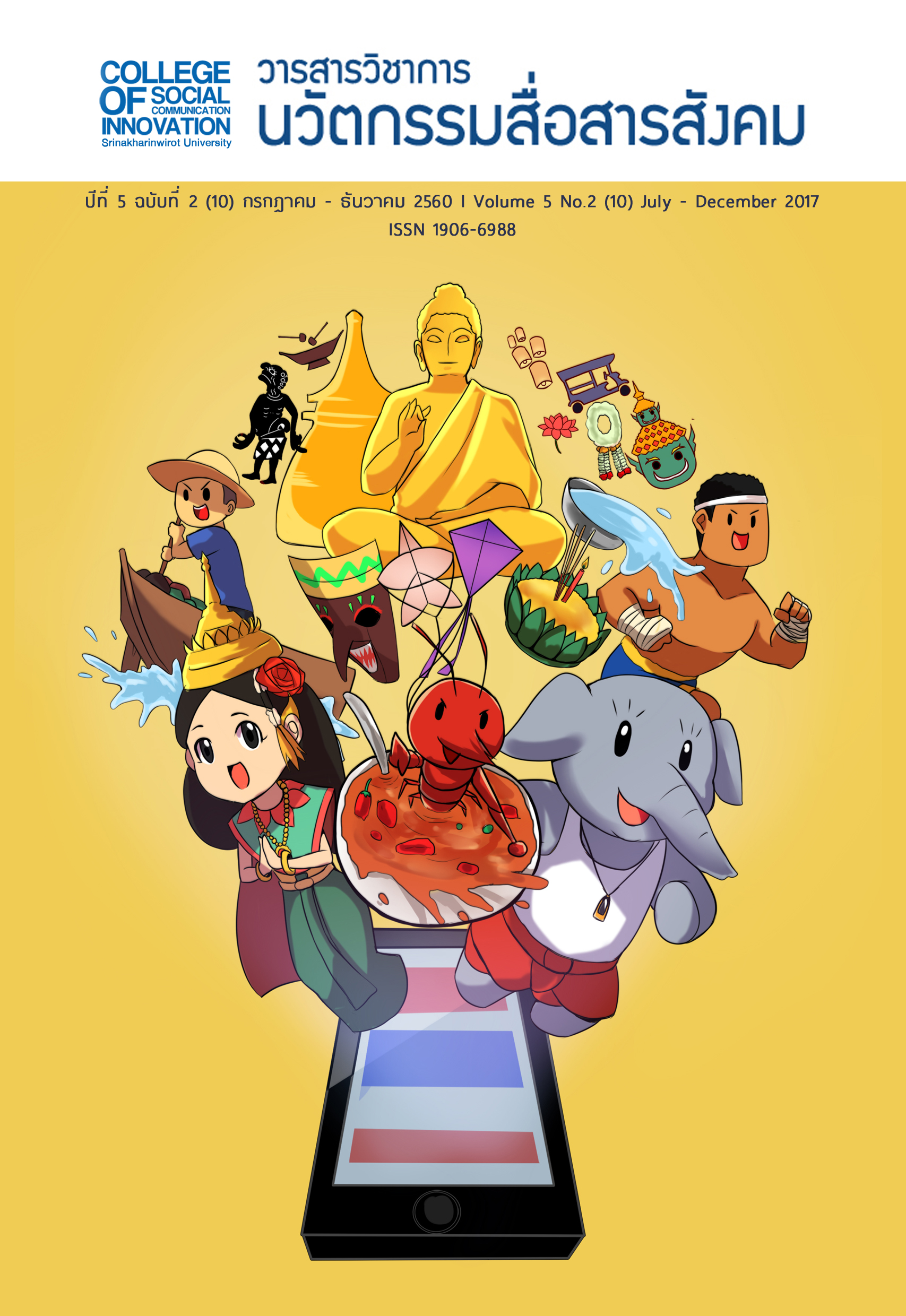การวิเคราะห์เนื้อหาสื่อโฆษณารณรงค์ต่อต้านการสูบบุหรี่ ในโทรทัศน์ไทย
(Content Analysis of Anti-Smoking Campaign Advertising Media on Thai TV)
คำสำคัญ:
ารวิเคราะห์เนื้อหาสื่อ, สื่อรณรงค์, ต่อต้านการสูบบุหรี่, content Analysis of Media, Media Campaign, Anti-Smokingบทคัดย่อ
บทคัดย่อ
การวิจัยนี้มีวัตถุประสงค์เพื่อวิเคราะห์เนื้อหาของสื่อรณรงค์ต่อต้านการสูบบุหรี่ที่นำเสนอในโทรทัศน์ประเทศไทย การวิจัยนี้เป็นการศึกษาสื่อรณรงค์ต่อต้านการสูบบุหรี่ที่นำเสนอในโทรทัศน์ประเทศไทย โดยใช้การวิเคราะห์เนื้อหาเป็นเครื่องมือในการวิจัย เพื่อให้ได้ทั้งข้อมูลพื้นฐานในการจัดทำสื่อดังกล่าว ตัวอย่างในการวิเคราะห์คือ สื่อรณรงค์ต่อต้านการสูบบุหรี่นำเสนอในโทรทัศน์ช่องฟรีของประเทศไทยที่อยู่ในรูปแบบโฆษณาตั้งแต่ปีพ.ศ. 2545-2558 จำนวน 25 เรื่องและสัมภาษณ์จากตัวแทนของผู้ผลิตสื่อฯ จำนวน 5 คน โดยเครื่องมือที่ใช้ในการวิจัยมีค่าความเชื่อมั่น เท่ากับ 0.875และสถิติที่ใช้วิเคราะห์ ได้แก่ ความถี่ ร้อยละ ค่าเฉลี่ย ส่วนเบี่ยงเบนมาตรฐาน
ผลการวิจัยพบว่า การวิเคราะห์สื่อโฆษณารณรงค์ต่อต้านการสูบบุหรี่ในโทรทัศน์ช่องฟรีของประเทศไทยที่อยู่ในรูปแบบโฆษณา เรื่อง พระคุณที่ไม่ทันได้ทดแทน มีจำนวนการ Views มากที่สุดถึง 1,564,861 ครั้ง และกลยุทธ์ของสารที่ใช้ในการเชิญชวน (Message Appeals) ของ Hawkinset al. (1998) พบว่า สื่อโฆษณารณรงค์ต่อต้านการสูบบุหรี่ในโทรทัศน์ช่องฟรีของประเทศไทยที่อยู่ในรูปแบบโฆษณาตั้งแต่ปีพ.ศ. 2545-2558 ส่วนใหญ่ใช้การจูงใจด้วยการสร้างอารมณ์ (Emotional appeals) จำนวน 12 เรื่อง คิดเป็นร้อยละ 48 ซึ่งเป็นการใช้การโฆษณาที่สร้างอารมณ์และความรู้สึกให้กับผู้บริโภคนิยมโดยเน้นที่การสร้างอารมณ์เพื่อให้เกิดความชอบเพิ่มขึ้น รองลงมา คือ การจูงใจด้วยความกลัว (Fear appeals) จำนวน 9 เรื่อง คิดเป็นร้อยละ 36 เป็นการแสดงให้เห็นผลหรืออันตรายที่จะเกิดขึ้นในทางไม่ดี หากผู้บริโภคไม่เปลี่ยนทัศนคติและพฤติกรรมและการจูงใจด้วยอารมณ์ขัน (Humorous appeals) จำนวน 4 เรื่อง คิดเป็นร้อยละ 16 ซึ่งเป็นการใช้อารมณ์ขันเพื่อดึงดูดความสนใจ และเปลี่ยนทัศคตินิยม แต่การใช้อารมณ์ขันจะต้องนำมาใช้ด้วยความระมัดระวัง จากผลการวิเคราะห์ข้างต้นแสดงให้เห็นถึงความสอดคล้องกันกับPaeket al. (2013) ที่ได้ศึกษาวิเคราะห์เนื้อหาวิดีโอต่อต้านการสูบบุหรี่บน YouTube พบว่า คุณค่าของการรับชมข้อความการเชิญชวนของสาร และความสัมพันธ์ระหว่างผู้รับสื่อนั้นขึ้นอยู่กับรูปแบบการเชิญชวนของสาร (Message Appeals) ที่แตกต่างกันไปเช่น ทำให้รู้สึกกลัว (Threat) ทำให้รู้สึกเกี่ยวกับสังคม (Social) และทำให้รู้สึกขบขัน (Humor) เป็นต้น
คำสำคัญ: การวิเคราะห์เนื้อหาสื่อ /สื่อรณรงค์ /ต่อต้านการสูบบุหรี่
Abstract
The objectives of research we’reto analyze the content analysis of anti-smoking advertisingcampaigns on Thai TV. This research was a study of anti-smoking mediacampaignshown on Thai television by using the content analysis as a research method to obtain basic information in the preparation of such media. The sample of the analysis included 25 anti-smoking advertising campaignsshown on free TV in Thailand. Between2002-2015,the researchers interviewed 5representatives from media producers. The instruments used in the research had a reliability value of 0.875 and the statistics used were frequency, percentage, mean, and standard deviation.
The content analysis of anti-smoking advertising campaignson Thai TV “the power of love” had the most views (1,564,861 views). The analysis was based on strategies ofMessage appeals (Hawkins et al. (1998)). The results of the content analysis of anti-smoking advertisingcampaigns on Thai TV found that the first strategy used in the advertisements was is Emotional appeals (12 cases, 48 %).These advertisementsattempted to draw on emotions and feelings of the consumers to increase fondness. The second is Fear appeals (9 cases, 36%).This type of work showed the results or the danger that wouldbadlyhappenif consumers did not change their attitudes and behaviors. And the last is Humorous appeals(4 cases, 16%), which used humor to attract and change the perception of the consumers.The findings were positively related to the study of Paek et al. (2013), who analyzed the cross-cultural comparison of interactivity and advertising appeals on antismoking websites and video content on YouTube in the United States and South Korea. The study found that the value of viewing,the invitation of messages, and the relationship between the recipients depend on the different types of strategies of message appeals, such as "Threat," "Social," and "Humorous appeals."
Keywords: Content Analysis of Media / Media Campaign / Anti-Smoking
ดาวน์โหลด
เผยแพร่แล้ว
รูปแบบการอ้างอิง
ฉบับ
ประเภทบทความ
สัญญาอนุญาต
บทความทุกบทความที่ได้รับการตีพิมพ์ถือเป็นลิขสิทธิ์ของวารสารวิชาการนวัตกรรมสื่อสารสังคม มหาวิทยาลัยศรีนครินทรวิโรฒ







